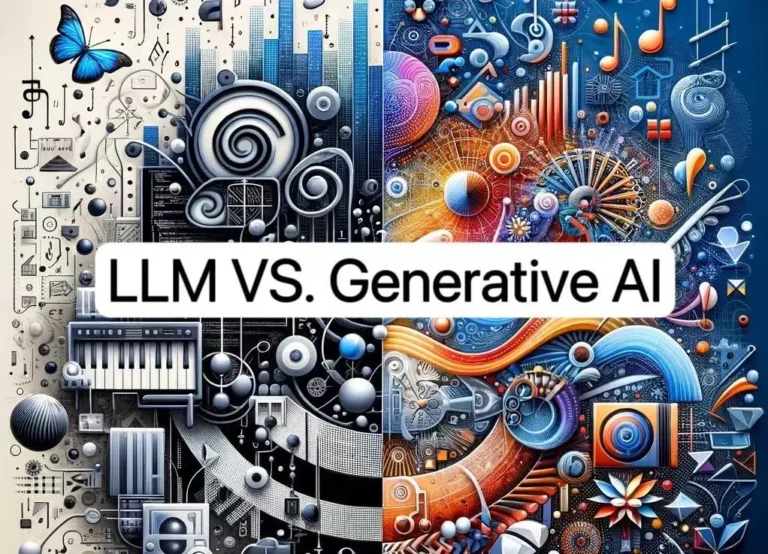Definition of LLM and Generative AI;
LLM is a type of machine learning that is based on language and makes use of natural language processing (NLP) algorithms in order to derive meaning from large amounts of written documents. What is done here is taking a neural network model and training it with several large datasets, be it books, articles or even tweets, to help the model get a sense of the natural use of language. As a result, the algorithm can produce sentences or other pieces of text based on the learned information in a structured manner. To put it differently, LLM is all about what comes next in a sentence or a paragraph and the model’s ability to be able to process a lot of information and build a full context.
In contrast, Generative AI is a term that is used in broad strokes in relation to any kind of Artificial Intelligence technology that has the capabilities to create something new and does not require human assistance. It includes but is not limited to, new images and music pieces, videos and even texts via deep learning, reinforcement learning, and evolutionary algorithms, among other methods. In contrast to LLM that heavily relies on NLP algorithms for generating language-based output, Generative AI takes a different approach by having different neural networks working in combination to create new content.
Applications of LLM and Generative AI;
Large language models are seeing use across many fields and there is a variety of integrations that they can be involved in. They are best known for their synthetic text generation and comprehension. These include chatbots that assist customers and make performing those interactions much more seamless.
But, Generative AI has a larger scope than just text. It generates images, music and videos as well. Musicians use it as a new way to be creative as it allows them to generate different types of images based on a specific theme.In terms of education, LLMs are used to create customised learning strategies. Generative algorithms contribute by designing interactive multimedia tools for presentation so that these resources are more appealing and benefit the individually designed study materials.
Both applied technologies are utilised by marketers as well – in developing content or recommending products. This would benefit brands in establishing a deeper relationship with their target consumers since information can be presented at the right time and situations.
Key Differences Between LLM and Generative AI Language Models ;
When it comes to the purpose of both llm vs generative ai, there is a clear-cut difference. LLMs are built for the understanding of language, even its subtle details. So, they stand out in comprehension activities such as summarising, or responding to questions.
- Purpose and Goal
For large language models, or LLMs, the desired output is similar to humans, that’s understanding and generation of language. It is constantly interpreting contexts and coming up with appropriate responses. Thus, they are suitable for answering questions, filling in gaps of text, and composing emails and the like.
- Training Process
In many significant aspects, the training process for LLMs (Large Language Models) and generative AI is different. As a rule, LLMs are trained on large collections of corpuses that embody different language types. Thus, they are able to grasp context, grammar, and semantics of language at a deeper level.
- Data requirements
Data requirements also begin to set boundaries LLMs and the Generative AI model. Large Language Models make use of huge textual datasets which often cover millions or billions of information texts. The approach helps them learn how to deploy linguistic tools effectively.
- Limitations
Clearly, LLMs and Generative AI are not perfect and have their limitations as well. Linguistics and Logic24110 have enormous learning abilities with language, yet they cannot deeply intuitively understand context. They may even produce text that reads well. However, many other factors will prevail in a long sequence that make sense as a logical flow, which is tough practically.
Examples of LLM and Generative AI in Action;
Content creators in recent years have been vastly changed by the technology such as LLM like OpenAI’s GPT3 Technology. It makes it possible to create content including for articles, blogs and also marketing material effortlessly with little or no input from the human. Companies make use of this technology to stimulate clients via call-centred instruments that respond instantly through the chatbots.
On the contrary, Generative AI performs incredibly well in creative industries. DALL-E, for example, makes impressive images based only on the description provided in text. It’s utilised by both artists and designers for the purpose of generating inspiration for exceptional images or concepts.In the context of gaming, generative models dynamically develop massive worlds and plots. This improves player satisfaction since such worlds are personalised to the choices made by the individual players.
These are some of the instances where LLMs are more directed towards language, while Generative AI is more about creativity in many forms, each contributing to the development of our digital world in their own way.
Conclusion:
The remission of LLM and Generative AI is largely dependent on one’s needs and objectives. A plausible answer will be an LLM, if one is searching for a model best suited for understanding context, language tasks, or generating human-like fashion text. Such models are trained to look at language in greater depth and nuance thus, they can handle complex questions efficiently.
However, assuming that your main purpose is to translate a core idea into new forms or altogether new objects as images or music, hence, generative AI may be a better match for such instances. And projects requiring Generative AI technology have a creative edge, so, in this case, it is here where the technology can be most accurately applied for the specific objective.
